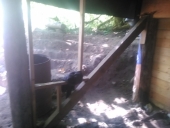




www.happyhigdons.blogspot.com








"You must be the change you want to see in the world." "First they ignore you, then they laugh at you, then they fight you, then you win." --Mahatma Gandhi
"Preach the Gospel always, and if necessary, use words." --Francis of Assisi.
"Family farms work when the whole family works the farm." -- Adam Klaus




http://wildernessreturn.wordpress.com/
my wilderness return story and adveture








www.happyhigdons.blogspot.com












Jeff Higdon wrote:
However, I got sprayed with some water that was in one of those tanks and it gave me a mild chemical burn. That got me to thinking: Do I really want to live with those chemicals in my house for the next 50 years?
After looking online, I came up with www.repurposedmaterialsinc.com. They sell 45 mil rubber roofing for $400 for about 2000 square feet.
The only problem is the holes and irregular shapes. I went and talked to a roofing contractor who installs it, and he told me of a tape you can buy to seam it, though I have not sourced that yet.
They also sell billboard vinyls which could be used for many applications.
 1
1





|
Does this tiny ad look rabid to you?
The new purple deck of permaculture playing cards
https://www.kickstarter.com/projects/paulwheaton/garden-cards
|




